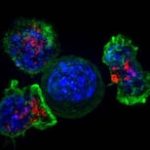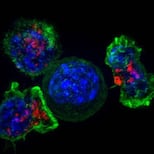




Around the entire planet, a case of blood cancer is diagnosed every 27 seconds, according to a study carried out by World Blood Cancer Day.

Citizens
Cordova. Surgeons used 3D prints to replace bones and joints in a cancer patient
The most common are lymphomas, leukemias and myeloma. While they are not preventable diseases, much can be done to make life easier for patients as they navigate the healthcare system. Therefore, within the framework of World Blood Cancer Day, which is commemorated this Tuesday, May 28, the Argentine Blood Cancer Alliance (ACSA), made up of the Argentine Lymphomas Civil Association (ACLA), the Argentine Myeloid Leukemia Association (ALMA) and the Argentine Myeloma Foundation (FAM), disseminated 5 measures aimed at that end.

TV
Health. Facundo Arana clarified that he does not have skin cancer: “My intention was to raise awareness”
Awareness campaigns
To improve diagnostic times, they consider it pertinent to carry out campaigns aimed at medical students and primary care doctors. A survey carried out by ACSA in 2023 and presented months ago at the congress of the Argentine Society of Hematology, had shown – among other data – that 4 out of 10 patients had to see 2 or 3 doctors before being referred to a hematologist. , who could best diagnose these diseases, and promptly initiate the appropriate treatment.
“We need primary care doctors to be more alert to the wide range of non-specific symptoms that may be manifesting the existence of a blood cancer; “That simple suspicion would allow us to save valuable time and life,” they said from ACSA.

Citizens
Health. Skin cancer: what is carcinoma and what is its treatment?
A big problem with these diseases is that the symptoms are usually non-specific and do not lead to suspicion. In a survey carried out by the Blood Cancer Alliance among 810 oncohematological patients at the end of 2023, patients with myeloma reported that the most common symptom was bone or joint pain; in leukemias, excessive fatigue, which does not facilitate suspicion at all; while, in lymphoma, it was the enlargement of nodes (which is more specific).
Therefore, Fernando Piotrowski, executive director of the Argentine Myeloid Leukemia Association, stressed that a message that the community should take away is “not to postpone going to the doctor in the event of unusual symptoms that draw your attention. It is always better to rule out the presence of any complex condition by performing simple studies, instead of allowing diseases to advance whose window of opportunity in early diagnosis can sometimes make a difference.”

Health
Cancer. Endocrine tumors constitute the fourth group of cancer with the greatest genetic predisposition
In the specific case of acute myeloid leukemia, which is the most common leukemia in adults, it progresses rapidly, so every day that passes counts and makes a difference.
Health systems navigation
Creation – for mandatory display and communication – of a clear navigation map in the different health systems. It is very different to have a prepaid plan and live in CABA than to have a provincial social work and live in the deep interior of the country. Beyond the fact that the possibilities and access to care will be different, the information on what to do, what documentation to present and where, to get coverage for this or that benefit approved, is very fragmented. It is not even possible to know where the nearest hematologist is.

Citizens
Health. Why removal of the appendix could reduce the risk of colorectal cancer
Today, technology allows access to practically any information with one or two clicks. So sometimes it seems that confusion and misinformation is preferred so that some patients are left behind and do not generate additional costs, ACSA suggested.
Shifts
Contemplation of double shifts in the event of diagnosis, relapses or treatment changes. “In complex chronic pathologies, such as oncohematological diseases, time counts and is decisive. For example, if a patient stops responding to the treatment they are taking and their disease progresses, they must be able to see their doctor within 24 to 48 hours, to be able to make new therapeutic decisions and achieve remission again and continue with their life. Shifts of 30 or 45 days in this type of case are absolutely inadmissible. It makes you go back 20 boxes, which may be unrecoverable,” explained Haydée González, president of the Argentine Linfomas Civil Association (ACLA).
Update of vademecums
Inclusion of innovative drugs in national and provincial formularies so that access is universal and equal. “At this point, we are constantly forced to insist that social insurance, prepaid and the State quickly update their formularies, because innovation brings treatments that are transforming the management of these diseases, our regulatory authority approves them, but then the patients They cannot receive them because it stops at the window of each one’s coverage,” acknowledged Mariana Auad, vice president and general coordinator of the Argentine Myeloma Foundation (FAM).
In the case of myeloma, it is auspicious that there is a lot of innovation because it is a pathology that usually causes relapses and patients may need to progressively advance to different lines of treatment. In that sense, the arrival and incorporation of new drug families precisely allows them to continue having different tools at their disposal.
Medication delivery
Regulation of delivery times that do not exceed 15 days. ACSA requests that universal mechanisms be established, which must be implemented by all forms of health coverage, that guarantee the prompt delivery of medication and that work be done to avoid interruptions in its supply throughout the treatment. The coverage of these medications is guaranteed by law, but – equally – many times patients must move heaven and earth so that the law that guarantees their right is fulfilled.
What are blood cancers?
Cancer caused by solid tumors is different from what is known as blood cancer or oncohematological diseases. In the first case, certain cells are altered and begin to produce malignant tissue in some part of the body; This is known as a tumor. It grows by feeding on blood vessels and, if left to its natural evolution, it has the possibility of migrating to other organs, in what is known as metastasis. In oncohematological diseases, however, the cells of the blood, bone marrow and lymph nodes are those that are altered, grow abnormally and reproduce uncontrollably, causing damage to the body, in part, because the blood stops fulfilling the functions it should. achieve.
The type of disease will depend on which blood cell is altered (plasma cells or white blood cells) and each one has more specificities to determine what type of disease occurs. Identification of the specific type of disease, often identifying at a molecular level, allows the best therapeutic decisions to be made to indicate the treatment that can achieve the best results specifically in each patient according to their disease, genetics and general state of health.

